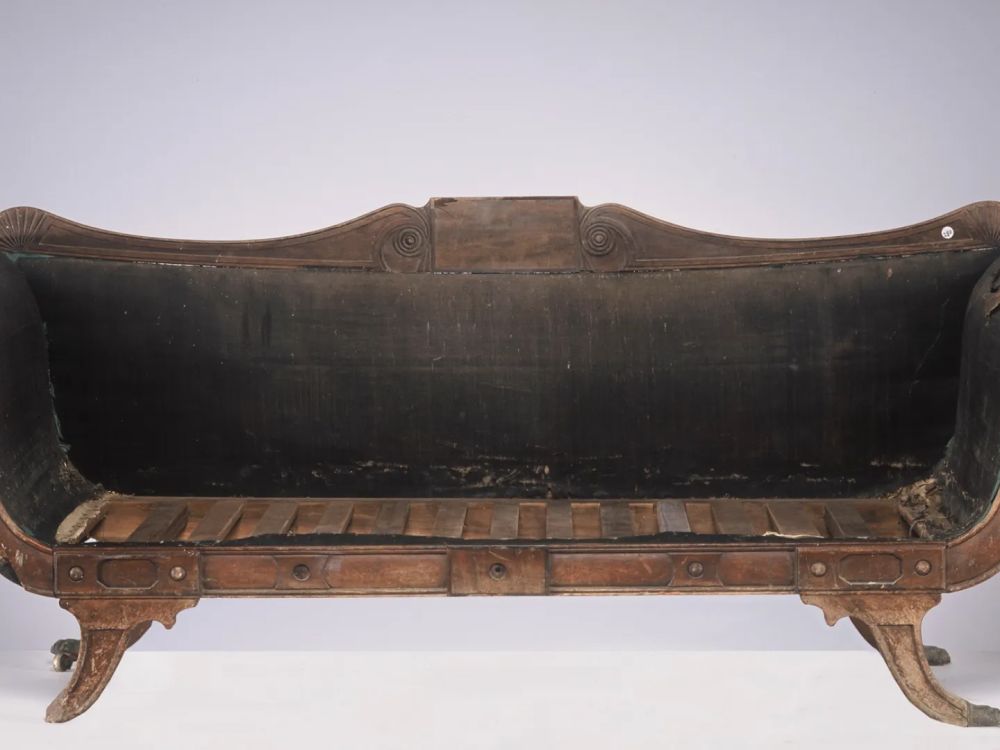Condition
Wood Work
The sofa was in remarkably good structural condition. The main damage included:
- Minor movement in leg and arm joints caused by shrinkage
- Structural damage on the sabre legs: two snapped off, one cracked and one stable.
- The proper right arm facing was split and missing a section on the lower curve
- Missing wooden button studs
- Ebonised banding detached
- Mahogany central panel partly detached
- Back of the entablature partly split
- The slats that support the mattress had old repairs,resulting in it sitting awkwardly
- All edge surfaces were heavily abraded and worn
Finish
The surface finish was heavily worn. All extant polished surfaces had lost their original finish with remnants remaining in recesses and mouldings where it had been protected under the mattress edge.
Metalware
The four brass lion paw castors survive, two with their brass wheels and brackets attached. All the castors were heavily tarnished, with minor areas of corrosion evident on the claws of the two castors that had broken off.
- The surface was dirty throughout due to age and natural degradation of the horsehair fabric. The sofa was visually a dull grey colour and much of its gloss had disappeared.
- Some areas of bird frass and some small drops of old cream paint were on the edges of the squab.
- The proper left arm rest had a jagged hole with a significant patch of original horsehair missing. A secondary piece of the same horsehair fabric, sourced
- from elsewhere on the sofa, was inserted into this hole and sewn down with large tacking stitches using a black cotton thread.
- The squab itself was in a degraded state. There were long breaks through the width of the squab.
- Much of the linen had been eaten and damaged by insects.
- Much of the top layer of horsehair fabric was worn and had small breaks in the individual fibres.
- Two flat iron marks were visible on one end of the squab.
- The sides of the squab had become loose from their original stitching, with the linen warp pulling free of the horsehair.
Treatment
Disassembly
- The sofa was received on a specially constructed cradle, which supported the frame whilst ensuring no weight was carried by the legs.
- Leaving the frame on the cradle, the back, cresting rail, facings and sabre legs were removed.
- Wood and finish identification and cleaning
- Wood samples were taken to confirm the timbers.
- All wooden surfaces were cleaned with a soft brush adjacent to a vacuum nozzle, then wet-cleaned using deionised water applied with cotton swabs.
Consolidation
- Detached components were glued into place using traditional hot animal glue.
- Splits were consolidated, and missing areas were patched and coloured with pigments and shellac.
- Areas of loss were infilled with a combination of pigmented hard wax and balsa.
- The replacement seat rail was replaced.
- The two missing wheels and forks were replaced (to match the originals).
Finishing
- The original shellac finish was resolubilised with methylated spirits and spread more evenly around the adjacent surfaces, providing a relatively uniform finish.
- A protective coating of microcrystalline wax was applied to the polished surface, with some pigmented tinting to provide extra colour and toning as required.
- Reassembly took place after all the finishing had been completed.
Upholstery components
- The horsehair fabric on the sofa body was surface cleaned using a brush vacuum.
- The frayed areas on the proper left arm rest were couched down to hold them in place.
- A lining was added on the squab, allowing significant tension to be created with the inserted couching stitches, pulling the squab back into its original shape.
- As there were significant creases in the horsehair fabric, the squab was left under weights for several weeks.
- The breaks were then re-pinned (if needed) and each section was couched down. The areas of loss around the iron marks were also treated in this way.
- The areas of damage in the linen were patched in individual sections with an ecru coloured cotton fabric.
- The breaks in the sides of the squab, where the linen and horsehair join, were also treated in this way.
Before treatment
After treatment






